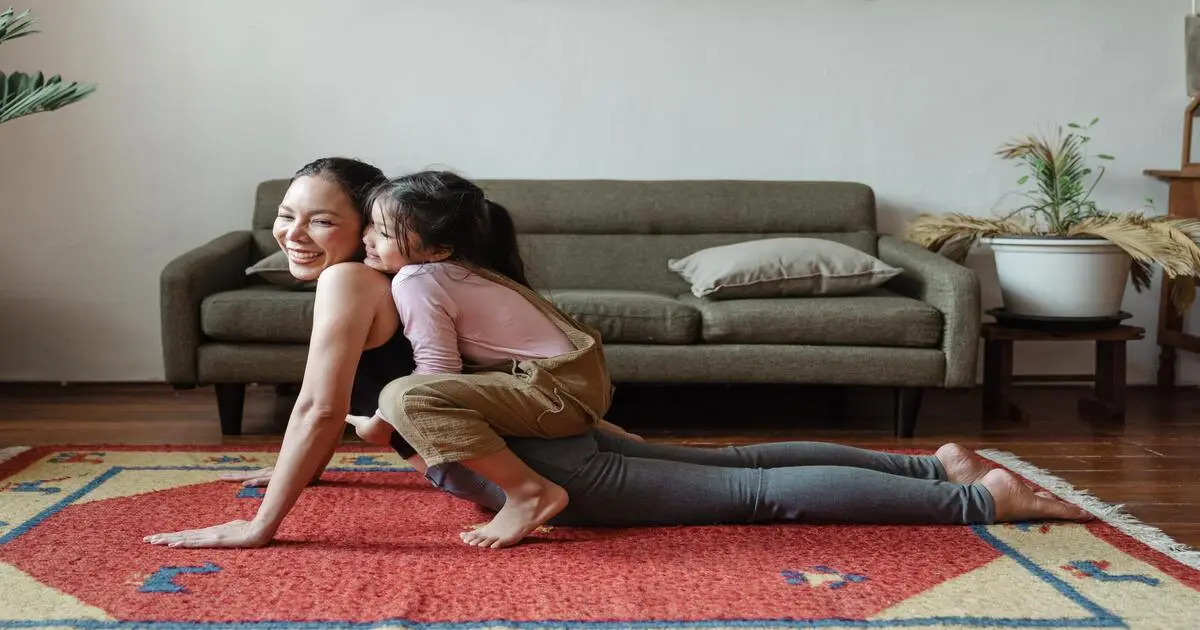Yin Yoga A Beginners Guide To Your Mind & Body!

Let’s talk about Yin yoga, your potential new best friend. Imagine a yoga class where you lie down, relax, and breathe. That’s Yin yoga for you. It’s the kind of yoga that doesn’t ask you to move much or sweat it out.
Instead, you get cozy in a pose and stay there for a while. like a good long hug for your muscles.
In this article, we’ll walk through what Yin yoga is all about. It’s the chill-out zone of the yoga world, where you can give some love to the parts of your body that are usually ignored.
We’ll examine why it’s good for you and how you can start without turning your living room into a yoga studio. Ready to get comfy? Let’s dive in.
What Is Yin Yoga
Yin yoga is rooted in ancient Chinese philosophies and Taoist principles, emphasizing the importance of balancing the complementary forces of yin and yang.
Yin represents stillness, darkness, and the moon, while yang symbolizes movement, brightness, and the sun.
In yin yoga, practitioners strive to balance these energies by focusing on the yin tissues within the body, including fascia and ligaments. This practice helps restore the healthy flow of Qi, the vital energy that runs through our bodies, promoting physical and mental well-being.
Origin and Evolution of Yin Yoga
Origin Timeline
Yin Yoga began to take shape, deeply rooted in the philosophies and practices of both yoga and martial arts.
Paul Grilley, influenced by Paulie Zink, developed long-held poses that became the foundation of Yin Yoga.
Naming of Yin Yoga
Sarah Powers, a student of Paul Grilley, suggested the name “Yin Yoga” to reflect the practice’s focus on passive, yielding qualities.
Evolution of Teaching
Paul Grilley transitioned from teaching dynamic styles like Vinyasa Yoga to incorporating passive stretching, significantly improving his students’ flexibility and range of motion.
Spread of Practice
During the 1980s-1990s, Yin Yoga spread rapidly, establishing itself as an integral part of modern yoga practices through an open-source lineage of teachers.
Comparative Data: Yin Yoga vs Hatha Yoga
Yin Yoga
Hatha Yoga
Modern Data
- Yin Yoga is now taught across North America and Europe, complementing active yoga practices.
- Restorative Yoga, a similar slow-paced practice, focuses on releasing mind-body tension and healing the nervous system, often using more props.
Is Yin Yoga OK for Beginners?
Yin yoga is an excellent choice for beginners. This gentle, meditative practice focuses on holding poses for extended periods, typically between two to five minutes, which allows for a deep stretch and promotes relaxation. Here’s why Yin yoga is particularly suited for those new to yoga:
Simplicity of Poses
It primarily involves seated or reclined poses that require minimal physical exertion, making it accessible for beginners. Poses such as the butterfly, seated forward fold, and Savasana (corpse pose) are simple yet effective in targeting deep connective tissues and ligaments.
This focus on passive stretching helps improve flexibility and joint mobility without the need for intense physical effort.
Focus on Breathing and Meditation
A key component of Yin yoga is its emphasis on breathing and mindfulness. By concentrating on your breath and holding poses for longer durations, you cultivate a meditative state that can reduce stress and promote mental clarity.
This aspect of yoga makes it not just a physical exercise but also a practice that enhances overall well-being.
Use of Props for Support
Beginners can greatly benefit from using yoga props such as blocks, bolsters, and blankets. These tools provide additional support and help maintain proper alignment, ensuring that you can stay in poses comfortably for longer periods.
Props are particularly useful in Yin yoga to achieve a “comfortable discomfort” without straining, which is crucial for the practice’s effectiveness.
Suitable for All Fitness Levels
Whether you are dealing with injuries, chronic conditions like arthritis, or simply looking for a gentle introduction to yoga, Yin yoga is adaptable to various needs.
It’s a restorative practice that complements more vigorous forms of exercise by promoting relaxation and recovery. Moreover, the non-heated environment of Yin yoga makes it easy to practice anywhere, anytime.
Building Compassion and Resilience
This practice encourages self-compassion and resilience, both physically and mentally. By focusing on inner sensations and accepting the present moment, practitioners learn to release tension and negative energy stored in the body.
This practice can be particularly transformative for beginners, helping them develop a positive relationship with their bodies and minds.
Yin yoga is highly recommended for beginners due to its simplicity, focus on breath and mindfulness, and adaptability to individual needs. With the right guidance and use of props, anyone can enjoy the profound benefits of this gentle yet powerful practice.
The Power of Yin Yoga
Yin yoga is a unique practice that offers profound benefits for both the body and mind. Unlike more dynamic yoga styles, Yin focuses on deep, passive stretches held for extended periods, typically between three to five minutes.
This approach targets the body’s connective tissues, such as ligaments, tendons, and fascia, promoting flexibility and joint mobility.
The slow, sustained pressure applied during Yin yoga poses allows connective tissues to expand gradually. This gradual stretching is crucial because it helps prevent injuries that can occur when these tissues are forced to stretch too quickly.
By improving the pliability of ligaments, tendons, and fascia, Yin yoga enhances overall flexibility and supports joint health.
Yin yoga not only stretches the deeper tissues but also improves blood circulation. Holding poses for longer durations increases oxygen and nutrient delivery to the tissues, promoting healing and vitality.
According to traditional Chinese medicine, Yin yoga stimulates the flow of Qi (energy) along the body’s meridian lines, balancing energy and enhancing overall well-being.
One of the most significant benefits of Yin yoga is its impact on the nervous system. The practice activates the parasympathetic nervous system, which calms the body and reduces stress.
The meditative aspect of holding poses for several minutes encourages mindfulness and present-moment awareness, helping to alleviate anxiety and improve mental clarity. This makes Yin yoga an excellent practice for those looking to unwind and find mental peace.
Yin yoga provides an opportunity for deep introspection. As practitioners hold poses, they become more attuned to their bodies, observing subtle sensations and emotions.
This heightened self-awareness fosters a stronger mind-body connection, promoting emotional resilience and self-discovery. In a world that’s always on the move, Yin yoga invites practitioners to slow down and listen to their bodies.
Yin yoga is suitable for individuals of all fitness levels, including those with injuries or chronic conditions such as arthritis or osteoporosis. Its gentle, non-strenuous nature supports healing and recovery, making it a valuable addition to any wellness routine.
Additionally, it complements more intense forms of exercise by providing balance and preventing burnout.
Subscribe to Create Higher Vibrations!
Get Inspiration and Practical advice straight to your inbox.
Key Principles of Yin Yoga
Yin yoga is grounded in the concept of surrendering to gravity and finding stillness within the body. The practice consists of seated or reclined poses, allowing the body to relax and release tension.
This stillness activates the parasympathetic nervous system, inducing a state of relaxation and reducing stress and anxiety levels.
Yin yoga also emphasizes internal awareness, encouraging practitioners to tune into their body’s sensations, thoughts, and emotions. This practice cultivates mindfulness and self-awareness, contributing to overall well-being.
the Benefits of Yin Yoga
What can you gain from a 30-minute yin yoga session? A lot, actually:
Your First Yin Yoga Session: A 30-Min Beginner’s Guide
Ready to dip your toes into the yin yoga pool? Here’s what you need:
Start by focusing on your breath—deep inhales, slow exhales. Feel the tension melt away as you settle into each posture. Whether you’re a “ra yoga” enthusiast or a yang yoga practitioner, yin yoga makes an excellent complement to any fitness regimen.
How To Start on Your Yin Yoga Practice
To begin practicing yin yoga, find a quiet and peaceful space free from distractions. Wear comfortable clothing and have props such as blocks and bolsters readily available to support your body during long holds.
The practice entails holding poses for extended periods, allowing the body to surrender and release tension.
Focus on your breath, inhaling and exhaling deeply and mindfully, while tuning into your body’s sensations. Yin yoga can be practiced independently or as a complement to another form of yoga, such as yang yoga or strength training.

Top Yin Yoga Poses for a Restorative Yoga Experience
Poses in yin yoga are held for a longer period, enabling the body to relax and release tension. Here are some of the most effective yin yoga postures to incorporate into your practice:
Joining a Yin Yoga Class
If you’re interested in trying a yin class, it’s recommended to find a class taught by a certified instructor, you can start yin yoga 30 min a day if needed. Search for yoga studios in your area or look online for yin yoga classes.
When attending your first class, be sure to discuss any injuries or concerns with the instructor. They can provide modifications or alternative poses to accommodate different body types and physical limitations.
Instructors may also implement the use of props such as blocks, straps, and blankets to assist with poses and make them more accessible.
A skilled yoga teacher can adjust students’ alignment and offer personalized adjustments to ensure they are practicing safely and effectively. Students must communicate any injuries or limitations to their teacher to receive proper guidance and modifications for their postures.
If you’re interested in exploring other styles of yoga, consider checking out the following articles:
A Turning Point in Bali: How I Discovered Yin Yoga Bali by Accident!
The first time I walked into a yin yoga studio in Bali, I was skeptical. I was a seasoned yang yoga practitioner, but something felt incomplete. The studio, named “Serenity Yin Yoga,” smelled of calming incense, and the atmosphere was unlike anything I had experienced.
Maya, the instructor, greeted me warmly. “Ready to discover yin yoga, Vishnu?” she asked. As we moved into our first pose, the Butterfly, a profound sense of release washed over me. Could holding a pose for minutes truly be this transformative?
When we transitioned into the Dragon pose, I felt an emotional weight lift, leaving me teary-eyed but lighter. By the time we reached the final Corpse pose, I felt renewed, as if layers of tension had melted away.
As I left the studio, I knew that yin yoga was what had been missing from my routine. It was not just another practice; it was a pathway to deeper self-awareness and balance.
That day marked the beginning of my yin yoga journey—a transformative experience that still shapes my life today. If you’re seeking something more in your practice, take it from me: Yin yoga might just be the answer.
Takeaway
Yin yoga is a deeply meditative and restorative yoga practice that offers numerous physical and mental health benefits.
Rooted in ancient Chinese philosophies and Taoist principles, it emphasizes the importance of balancing yin and yang. The practice involves long-held poses, allowing the body to surrender and release tension, promoting relaxation and mindfulness.
Yin yoga practice is complementary to other forms of exercise, providing balance and relaxation to an intense fitness routine. It’s an ideal starting point for those interested in mindfulness and meditation, promoting self-awareness and internal focus.
With its emphasis on stillness and internal awareness, yin yoga is an excellent addition to anyone’s wellness routine. Start the transformative power of yin yoga and experience the profound benefits it brings to body and mind.
Namaste


